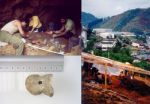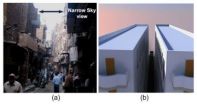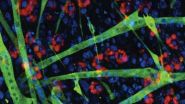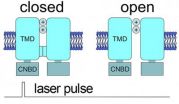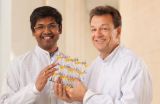(Press-News.org) A new study shows that domestic abuse is closely linked to postpartum mental health problems, including depression and post-traumatic stress disorder (PTSD), in mothers. The research also found that specific types of abuse are associated with specific mental health problems. The work was done by researchers at North Carolina State University, Simon Fraser University and the University of British Columbia.
"We wanted to see whether and how intimate partner abuse – physical, psychological and sexual – influenced postpartum mental health in women, including problems such as depression, stress, anxiety, obsessive-compulsive disorder (OCD), and PTSD," says Dr. Sarah Desmarais, an assistant professor of psychology at NC State and lead author of a paper on the work.
The researchers interviewed 100 women from British Columbia who were largely from higher socioeconomic backgrounds and were not considered at high risk of postpartum mental health problems. The study participants were recruited to participate in a broad health and wellness study, which was not specifically focused on domestic abuse.
Sixty-one percent of the study participants reported symptoms of postpartum mental health problems within the first three months after childbirth. And 47 percent of the 100 women reported symptoms at "clinical" levels, meaning the symptoms were of at least moderate severity.
Eighty-four percent of the participants reported experiencing physical, psychological or sexual abuse at the hands of a partner prior to becoming pregnant. Seventy percent of the 100 participants reported some form of abuse by their romantic partner during pregnancy. These forms of abuse ranged from name-calling to rape and physical assault with a weapon.
"We found that women who had experienced abuse were more likely to suffer from postpartum mental health problems, and were much more likely to suffer from those problems if the abuse occurred during pregnancy," Desmarais says. "In addition, the more types of abuse they experienced, the more severe the mental health symptoms they reported. We also found that specific types of abuse were associated with specific problems."
The researchers found that psychological abuse – verbal and emotional abuse – was associated with stress and PTSD. Physical abuse was associated with depression, OCD and PTSD. Sexual abuse was associated with stress, depression and PTSD.
This means that some mental health problems could stem from any of the forms of abuse. For example, PTSD is associated with all three forms of abuse, but could be caused by any one of them; psychological abuse alone could lead to PTSD.
"This highlights the need for increased awareness of the prevalence of these issues, and the need for increased screening for abuse and mental health problems for pregnant women and new mothers," Desmarais says.
"The sheer scope of the mental health problems and types of abuse that we found tells us that we need to take a broader approach to tackling these issues," Desmarais adds. "And this is clearly not a 'lower class' problem – medical professionals everywhere need to pay attention.
"But to do this effectively, we need to train doctors, nurses, and hospital staff in how to identify and respond to potential problems in this area."
INFORMATION:
The paper, "Intimate partner abuse before and during pregnancy as risk factors for postpartum mental health problems," is published online in the open-access journal BMC Pregnancy and Childbirth. The paper was co-authored by Ashley Pritchard of Simon Fraser University; Evan Lowder, a graduate student at NC State; and Dr. Patricia Janssen of UBC. This research was supported by the British Columbia Mental Health and Addictions Research Network, the Social Sciences and Humanities Research Council of Canada, and the Michael Smith Foundation for Health Research.
Study links domestic abuse to mental health problems in new mothers
2014-04-14
ELSE PRESS RELEASES FROM THIS DATE:
Neanderthals and Cro-magnons did not coincide on the Iberian Peninsula
2014-04-14
This news release is available in Spanish. Until now, the carbon 14 technique, a radioactive isotope which gradually disappears with the passing of time, has been used to date prehistoric remains. When about 40,000 years, in other words approximately the period corresponding to the arrival of the first humans in Europe, have elapsed, the portion that remains is so small that it can become easily contaminated and cause the dates to appear more recent. It was from 2005 onwards that a new technique began to be used; it is the one used to purify the collagen in DNA tests. ...
Let the sun shine in: Redirecting sunlight to urban alleyways
2014-04-14
WASHINGTON, April 14—In dense, urban centers around the world, many people live and work in dim and narrow streets surrounded by tall buildings that block sunlight. And as the global population continues to rise and buildings are jammed closer together, the darkness will only spread.
To alleviate the problem, Egyptian researchers have developed a corrugated, translucent panel that redirects sunlight onto narrow streets and alleyways. The panel is mounted on rooftops and hung over the edge at an angle, where it spreads sunlight onto the street below. The researchers describe ...
Wolves at the door: Study finds recent wolf-dog hybridization in Caucasus region
2014-04-14
Dog owners in the Caucasus Mountains of Georgia might want to consider penning up their dogs more often: hybridization of wolves with shepherd dogs might be more common, and more recent, than previously thought, according to a recently published study in the Journal of Heredity (DOI: 10.1093/jhered/esu014).
Dr. Natia Kopaliani, Dr. David Tarkhnishvili, and colleagues from the Institute of Ecology at Ilia State University in Georgia and from the Tbilisi Zoo in Georgia used a range of genetic techniques to extract and examine DNA taken from wolf and dog fur samples as well ...
Regenerating muscle in Duchenne muscular dystrophy: Age matters
2014-04-14
LA JOLLA, Calif., April 11, 2014 — A team of scientists led by Pier Lorenzo Puri, M.D., associate professor at Sanford-Burnham Medical Research Institute (Sanford-Burnham), in collaboration with Fondazione Santa Lucia in Rome, Italy, have published details of how a class of drugs called "HDACis" drive muscle-cell regeneration in the early stages of dystrophic muscles, but fail to work in late stages. The findings are key to furthering clinical development of HDACis for Duchenne muscular dystrophy (DMD), an incurable muscle-wasting disease.
A symphony to rebuild muscle
The ...
New 'tunable' semiconductors will allow better detectors, solar cells
2014-04-14
One of the great problems in physics is the detection of electromagnetic radiation – that is, light – which lies outside the small range of wavelengths that the human eye can see. Think X-rays, for example, or radio waves.
Now, researchers have discovered a way to use existing semiconductors to detect a far wider range of light than is now possible, well into the infrared range. The team hopes to use the technology in detectors, obviously, but also in improved solar cells that could absorb infrared light as well as the sun's visible rays.
"This technology will also ...
A stable model for an unstable target
2014-04-14
A study in The Journal of General Physiology provides new insights about singlet oxygen and sets the stage for better understanding of this highly reactive and challenging substance.
Singlet oxygen is an electronically excited state of oxygen that is less stable than normal oxygen. Its high reactivity has enabled its use in photodynamic therapy, in which light is used in combination with a photosensitizing drug to generate large amounts of singlet oxygen to kill cancer cells or various pathogens.
Light-generated singlet oxygen also plays a role in a range of biological ...
Better solar cells, better LED light and vast optical possibilities
2014-04-14
Changes at the atom level in nanowires offer vast possibilities for improvement of solar cells and LED light. NTNU-researchers have discovered that by tuning a small strain on single nanowires they can become more effective in LEDs and solar cells.
NTNU researchers Dheeraj Dasa and Helge Weman have, in cooperation with IBM, discovered that gallium arsenide can be tuned with a small strain to function efficiently as a single light-emitting diode or a photodetector. This is facilitated by the special hexagonal crystal structure, referred to as wurtzite, which the NTNU ...
Pioneering findings on the dual role of carbon dioxide in photosynthesis
2014-04-14
Scientists at Umeå University in Sweden have found that carbon dioxide, in its ionic form bicarbonate, has a regulating function in the splitting of water in photosynthesis. This means that carbon dioxide has an additional role to being reduced to sugar. The pioneering work is published in the latest issue of the scientific journal PNAS.
It is well known that inorganic carbon in the form of carbon dioxide, CO2, is reduced in a light driven process known as photosynthesis to organic compounds in the chloroplasts. Less well known is that inorganic carbon also affects the ...
The result of slow degradation
2014-04-14
This news release is available in German. Although persistent environmental pollutants have been and continue to be released worldwide, the Arctic and Antarctic regions are significantly more contaminated than elsewhere. The marine animals living there have some of the highest levels of persistent organic pollutant (POP) contamination of any creatures. The Inuit people of the Arctic, who rely on a diet of fish, seals and whales, have also been shown to have higher POP concentrations than people living in our latitudes.
Today, the production and use of nearly two dozen ...
Nutrient-rich forests absorb more carbon
2014-04-14
The ability of forests to sequester carbon from the atmosphere depends on nutrients available in the forest soils, shows new research from an international team of researchers including the International Institute for Applied Systems Analysis (IIASA).
The study showed that forests growing in fertile soils with ample nutrients are able to sequester about 30% of the carbon that they take up during photosynthesis. In contrast, forests growing in nutrient-poor soils may retain only 6% of that carbon. The rest is returned to the atmosphere as respiration.
"This paper produces ...
